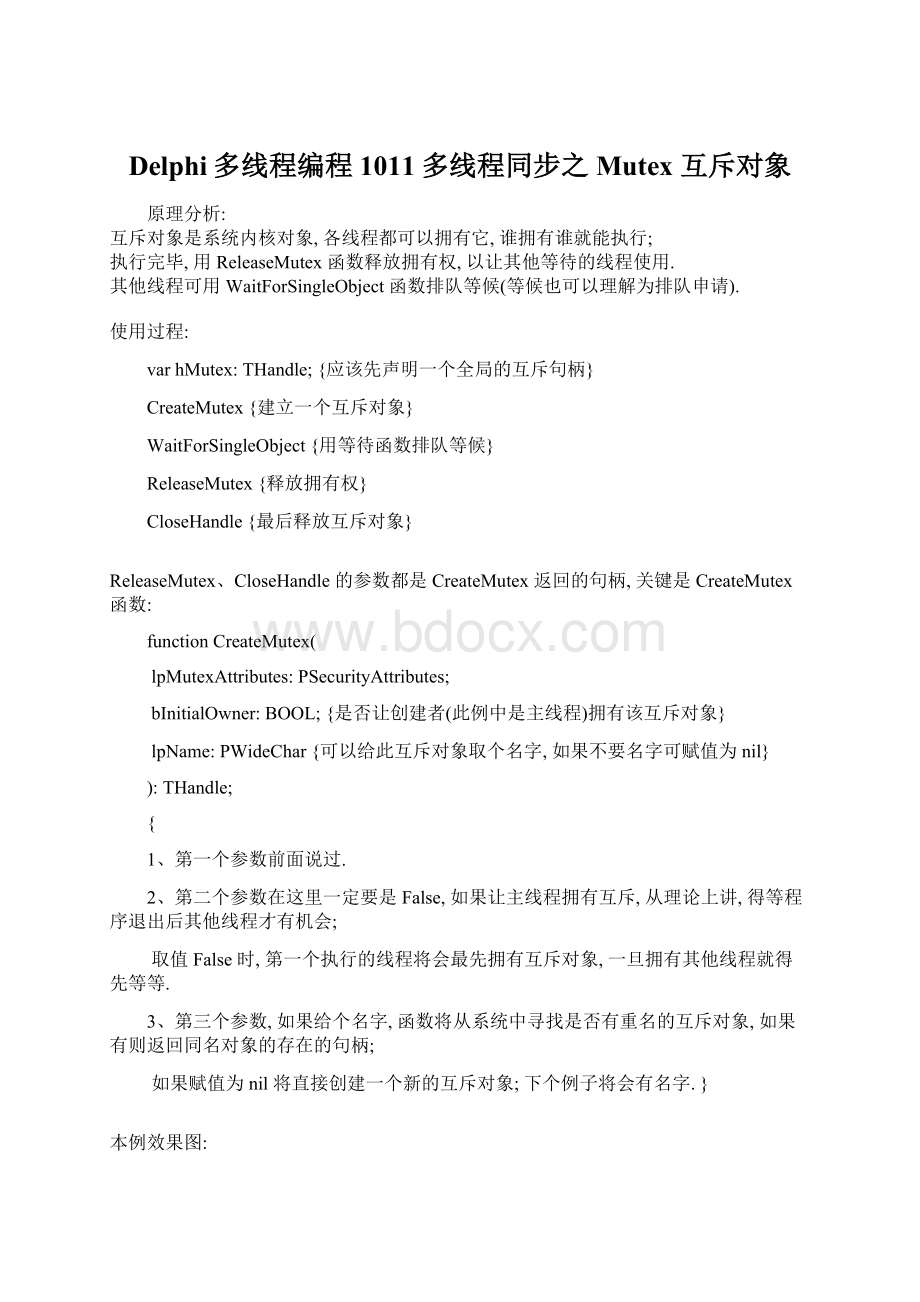Delphi多线程编程1011多线程同步之 Mutex 互斥对象.docx
《Delphi多线程编程1011多线程同步之 Mutex 互斥对象.docx》由会员分享,可在线阅读,更多相关《Delphi多线程编程1011多线程同步之 Mutex 互斥对象.docx(9页珍藏版)》请在冰豆网上搜索。

Delphi多线程编程1011多线程同步之Mutex互斥对象
原理分析:
互斥对象是系统内核对象,各线程都可以拥有它,谁拥有谁就能执行;
执行完毕,用ReleaseMutex函数释放拥有权,以让其他等待的线程使用.
其他线程可用WaitForSingleObject函数排队等候(等候也可以理解为排队申请).
使用过程:
varhMutex:
THandle;{应该先声明一个全局的互斥句柄}
CreateMutex{建立一个互斥对象}
WaitForSingleObject{用等待函数排队等候}
ReleaseMutex{释放拥有权}
CloseHandle{最后释放互斥对象}
ReleaseMutex、CloseHandle的参数都是CreateMutex返回的句柄,关键是CreateMutex函数:
functionCreateMutex(
lpMutexAttributes:
PSecurityAttributes;
bInitialOwner:
BOOL;{是否让创建者(此例中是主线程)拥有该互斥对象}
lpName:
PWideChar{可以给此互斥对象取个名字,如果不要名字可赋值为nil}
):
THandle;
{
1、第一个参数前面说过.
2、第二个参数在这里一定要是False,如果让主线程拥有互斥,从理论上讲,得等程序退出后其他线程才有机会;
取值False时,第一个执行的线程将会最先拥有互斥对象,一旦拥有其他线程就得先等等.
3、第三个参数,如果给个名字,函数将从系统中寻找是否有重名的互斥对象,如果有则返回同名对象的存在的句柄;
如果赋值为nil将直接创建一个新的互斥对象;下个例子将会有名字.}
本例效果图:
代码文件:
unitUnit1;
interface
uses
Windows,Messages,SysUtils,Variants,Classes,Graphics,Controls,Forms,
Dialogs,StdCtrls;
type
TForm1=class(TForm)
Button1:
TButton;
procedureButton1Click(Sender:
TObject);
procedureFormCreate(Sender:
TObject);
procedureFormDestroy(Sender:
TObject);
end;
var
Form1:
TForm1;
implementation
{$R*.dfm}
var
f:
Integer;{用这个变量协调一下各线程输出的位置}
hMutex:
THandle;{互斥对象的句柄}
functionMyThreadFun(p:
Pointer):
DWORD;stdcall;
var
i,y:
Integer;
begin
Inc(f);
y:
=20*f;
fori:
=0to50000do
begin
ifWaitForSingleObject(hMutex,INFINITE)=WAIT_OBJECT_0then
begin
Form1.Canvas.Lock;
Form1.Canvas.TextOut(20,y,IntToStr(i));
Form1.Canvas.Unlock;
Sleep(0);{稍稍耽搁一点,不然有时Canvas会协调不过来}
ReleaseMutex(hMutex);
end;
end;
Result:
=0;
end;
procedureTForm1.Button1Click(Sender:
TObject);
var
ThreadID:
DWORD;
begin
Repaint;
f:
=0;
CreateThread(nil,0,@MyThreadFun,nil,0,ThreadID);
CreateThread(nil,0,@MyThreadFun,nil,0,ThreadID);
CreateThread(nil,0,@MyThreadFun,nil,0,ThreadID);
CreateThread(nil,0,@MyThreadFun,nil,0,ThreadID);
CreateThread(nil,0,@MyThreadFun,nil,0,ThreadID);
end;
procedureTForm1.FormCreate(Sender:
TObject);
begin
hMutex:
=CreateMutex(nil,False,nil);
end;
procedureTForm1.FormDestroy(Sender:
TObject);
begin
CloseHandle(hMutex);
end;
end.
窗体文件:
objectForm1:
TForm1
Left=0
Top=0
Caption='Form1'
ClientHeight=140
ClientWidth=192
Color=clBtnFace
Font.Charset=DEFAULT_CHARSET
Font.Color=clWindowText
Font.Height=-11
Font.Name='Tahoma'
Font.Style=[]
OldCreateOrder=False
OnCreate=FormCreate
PixelsPerInch=96
TextHeight=13
objectButton1:
TButton
Left=109
Top=107
Width=75
Height=25
Caption='Button1'
TabOrder=0
OnClick=Button1Click
end
end
SyncObjs单元下有封装好的TMutex类,好像不如Api快,内部机制也稍有区别,但使用方法差不多:
unitUnit1;
interface
uses
Windows,Messages,SysUtils,Variants,Classes,Graphics,Controls,Forms,
Dialogs,StdCtrls;
type
TForm1=class(TForm)
Button1:
TButton;
procedureButton1Click(Sender:
TObject);
procedureFormCreate(Sender:
TObject);
procedureFormDestroy(Sender:
TObject);
end;
var
Form1:
TForm1;
implementation
{$R*.dfm}
usesSyncObjs;
var
f:
Integer;
MyMutex:
TMutex;
functionMyThreadFun(p:
Pointer):
DWORD;stdcall;
var
i,y:
Integer;
begin
Inc(f);
y:
=20*f;
fori:
=0to50000do
begin
ifMyMutex.WaitFor(INFINITE)=wrSignaledthen
begin
Form1.Canvas.Lock;
Form1.Canvas.TextOut(20,y,IntToStr(i));
Form1.Canvas.Unlock;
MyMutex.Release;
end;
end;
Result:
=0;
end;
procedureTForm1.Button1Click(Sender:
TObject);
var
ThreadID:
DWORD;
begin
Repaint;
f:
=0;
CreateThread(nil,0,@MyThreadFun,nil,0,ThreadID);
CreateThread(nil,0,@MyThreadFun,nil,0,ThreadID);
CreateThread(nil,0,@MyThreadFun,nil,0,ThreadID);
CreateThread(nil,0,@MyThreadFun,nil,0,ThreadID);
CreateThread(nil,0,@MyThreadFun,nil,0,ThreadID);
end;
procedureTForm1.FormCreate(Sender:
TObject);
begin
MyMutex:
=TMutex.Create(False);
end;
procedureTForm1.FormDestroy(Sender:
TObject);
begin
MyMutex.Free;
end;
end.
Mutex作为系统核心对象是可以跨进程的(临界区就不行),我们可以利用互斥对象禁止程序重复启动.
工作思路:
先用OpenMutex尝试打开一个自定义名称的Mutex对象,如果打开失败说明之前没有这个对象存在;
如果之前没有这个对象,马上用CreateMutex建立一个,此时的程序应该是第一次启动;
再重复启动时,那个OpenMutex就有结果了,然后强制退出.
最后在程序结束时用CloseHandle释放Mutex对象.
functionOpenMutex(
dwDesiredAccess:
DWORD;{打开权限}
bInheritHandle:
BOOL;{能否被当前程序创建的进程继承}
pName:
PWideChar{Mutex对象的名称}
):
THandle;stdcall;{成功返回Mutex的句柄;失败返回0}
注意,这里的CreateMutex函数应该有个名了,因为OpenMutex要用到;
另外,CreateMutex的第二个参数已经不重要了(也就是True和False都行),因为这里是用其名称来判断的.
程序可以这样写:
unitUnit1;
interface
uses
Windows,Messages,SysUtils,Variants,Classes,Graphics,Controls,Forms,
Dialogs;
type
TForm1=class(TForm)
procedureFormCreate(Sender:
TObject);
procedureFormDestroy(Sender:
TObject);
end;
var
Form1:
TForm1;
implementation
{$R*.dfm}
var
hMutex:
THandle;
const
NameMutex='MyMutex';
procedureTForm1.FormCreate(Sender:
TObject);
begin
ifOpenMutex(MUTEX_ALL_ACCESS,False,NameMutex)<>0then
begin
ShowMessage('该程序已启动');
Application.Terminate;
end;
hMutex:
=CreateMutex(nil,False,NameMutex);
end;
procedureTForm1.FormDestroy(Sender:
TObject);
begin
CloseHandle(hMutex);
end;
end.
这一般都是写在dpr主程序里,省得让后启动的程序执行些无用的代码:
programProject1;
uses
Forms,Windows,
Unit1in'Unit1.pas'{Form1};
{$R*.res}
var
hMutex:
THandle;
const
NameMutex='MyMutex';
begin
{主线程入口}
ifOpenMutex(MUTEX_ALL_ACCESS,False,NameMutex)<>0then
begin
MessageBox(0,'该程序已启动','提示',MB_OK);
Application.Terminate;
end;
hMutex:
=CreateMutex(nil,False,NameMutex);
Application.Initialize;
Application.MainFormOnTaskbar:
=True;
Application.CreateForm(TForm1,Form1);
Application.Run;
CloseHandle(hMutex);
{主线程出口}
end.